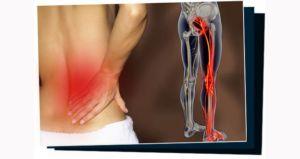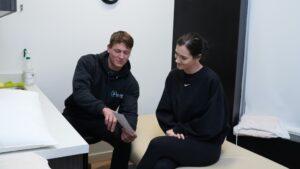For sure, pain in your back is a real annoyance. Back pain can greatly interrupt your sleeping pattern, your ability to exercise and work. But wait! Pain can be worrisome when it is radiating down into backside and leg that can severely impact your life. Yes! This is the sciatica pain.

Many people associate sciatica with older people, and they think they don’t need to worry about this condition.
Did we mention?
‘According to research, sciatica is common among people between ages 30-50 years. No doubt, wear and tear of aging can cause sciatica. But several other causes are not related to age, and yet lead to sciatica.’
What is Sciatica?
Sciatica refers to the medical condition in which pain is caused by sciatic nerves. This pain felt along the sciatic nerve runs down through buttock and into the back of the lower leg.
Sciatica pain and back pain are two different pains. People often suffer from back pain for many reasons, but once this pain starts radiating down to your backside, it is sciatica. You probably have heard from people suffering from sciatica who describe it as a ‘shooting pain’ on any one side of their body.
Compression in the sciatic nerves can be a ‘pain in the butt’ for patients. In many cases, sciatica pain doesn’t need any medical attention. But at sometimes, home remedies cannot treat sciatica pain. Sometimes, physical therapy can be the best solution to banish sciatica pain.

Sciatica pain is said to be unlike other body pains. Due to its shooting sensation, it is often said that ‘you’ll know it when you feel it’. But this sign cannot be enough to assure you that you are suffering from sciatica. You must know the causes of sciatica pain. Let’s face it!
Causes behind Sciatica Pain
Sciatic nerve is one of the longest nerves in the body. Sciatica pain results when this nerve is compressed or irritates. Below mentioned are the four causes behind sciatica pain.
· Spinal Stenosis
When open spaces in the spinal column become narrow, this puts pressure on the sciatic nerve, causing numbness, tingling, and weakness.
· Herniated Disc
Disc acts like cushions between vertebrae making up spine. Herniated disc, also known as ruptured or slipped disc occurs when jelly-like substance pushes out of the disc due to any tear. This condition puts pressure on the sciatic nerve causing pain and numbness.
· Spondylolisthesis
This condition refers to dislocated vertebrae. Due to slip of vertebrae out of its position, sciatic nerve or spinal cord is squeezed, resulting in sciatic pain.
· Piriformis Syndrome
In this disorder, your sciatic nerve is compressed by the piriformis muscle, which passes through the buttock, which results in sciatic pain. This syndrome is a common cause among athletes.
Symptoms of Sciatica
Sciatica pain can vary between burning, aching sensations, dull, sharp, and shooting pains. In the affected leg, sciatica can cause numbness, tingling, and muscle weakness.

Compression of the sciatic nerve, in the long run, can cause permanent nerve damage and in its functioning. This condition may lead to permanent symptoms. Some of the symptoms of sciatica are mentioned below:
- Pain the leg or rear part that become worse when sitting
- Tingling or burning in the affected leg
- Difficulty moving the foot or leg, muscle weakness and numbness
- Chronic pain in one side of the rear calf
- Shooting pain causing difficulty to stand up
Top Indicators of Sciatica Pain that you must see a Physiotherapist
· Severity of Symptoms
Due to chronic compression of the sciatic nerve, resulting symptoms can be painful and embarrassing too. People suffering from sciatica pain can become numb and weak. Due to the severity of symptoms, it can become impossible to move your leg or foot. If the sciatic pain hits suddenly with great intensity, it is high time you seek a physical therapist who will help ease your pain.

Another thing to worry about sciatica pain is that sciatic nerve can be irritated or compressed in those areas that are responsible for controlling your bowel and bladder functions. Let’s assume if you lose control of your bowel and bladder functions. It’s quite frightening, right? So immediately seek help from a professional who will run tests and refer to an expert physical therapist.
· Pain Follows Injury
Over time, mild symptoms of sciatica can become severe, and sometimes these symptoms go away on their own. However, the onset of sciatic symptoms following any trauma or injury such as from sports injury, car accident, or any fall, it is essential that you consult to medical professional or physiotherapist.
Following an injury, sciatic symptoms can be severe due to the intense impact on the sciatic nerve and its surroundings. To analyse the extent of nerve damage, you need to seek help from professionals. Physical therapy is recommended to such patients as an essential part of their recovery plan. Physical therapist can extend the benefits of your sciatica medication through appropriate therapies to reduce pain.
· Failure of Home Remedies
With the purpose to ease mild symptoms of sciatica, there are several things one can do at home. For instance, alternating with heat and cold treatment is one classic way to ease sciatica pain. Similarly, sleeping with a pillow keeping in between your knees can help reduce pain. However, resting your achy back and leg can make your condition worse, so a regular walk is necessary to ease the pain.

But if you’ve tried all the home remedies to treat your sciatica pain, and you see no reduction in pain, it’s the time to seek help from a trained physical therapist.
Why is Physical Therapy beneficial for Sciatica Patient?
Your spine doctor may likely refer you to the expert physical therapists. It is essential to speed up your recovery from sciatica pain. Physical therapists help reduce pain and inflammation, improve physical functions, restore movement, and reduce muscle tension while strengthening weakened muscles.

Physical therapy also helps people in improving their posture. Physical therapy also includes some exercises and muscle stretching techniques that help improve the overall physical health of the sciatic patient.
Final Verdict
Now that you know about the indicators that you need to seek a physical therapist and how they can help you reduce your sciatica pain, it is the time that you seek help from them.
Physical therapy can be a lifeline for people who are suffering from sciatica pain. Physical therapists will teach you how to strengthen your lower back through some targeted moves. Strong muscles can help support the area of the sciatic nerve and thereby, prevent patients from future injuries.







